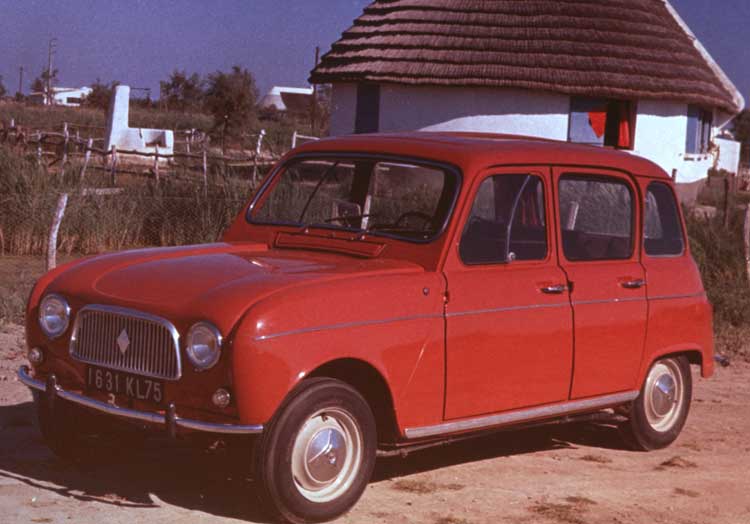Renault 4
The Renault 4, often likened to a hen coop, was still a success, writes Sean O'Grady

A friend of mine had one of these. I can still remember travelling in it even after the guys at the MoT test station refused to go underneath to inspect its condition, because it was too dangerous. I also remember him driving the thing at top speed (about 85mph) on the M1, Duran Duran at full blast, with the reassuring words "if we have a high speed blow out now, we're dead." It was metallic brown with black vinyl seats (handy if your post-pub kebab dripped a bit) and was a 1977 model.
A mere decade old, it was ready to be crushed as soon as its MoT certificate ran out. Yet it wasn't really supposed to be that sort of car – a 1970s and 1980s version of today's knackered Corsas and Civics, driven into the ground by youthful, enthusiastic motorists.
When they brought it out in 1961, Renault wanted their roomy mini-estate to be a kind of upmarket Citroen 2CV, the archetypal French peasant-mobile. It was a little more luxurious than its well-established rival, appealing to the French equivalent of the kulak class. In Britain, like the 2CV, it became established as a public sector sort of car, but whereas social workers tended to favour the 2CV with a clichéd "Nuclear Power? Nein Danke!" smiley sticker on the back, the Renault was much more likely to be piloted by a school teacher.
One of our French teachers did indeed drive a 1974 bright yellow job, which clashed rather badly with his habitual purple jacket, a style of dress which in turn provided its own juxtaposition to his Viking-red hair and beard. When he stood next to his boxy car he looked like a Rothko painting. That said, he is the sole reason that I can ask for a beer in a French bar, but I digress.
The mid 1970s marked the peak of the Renault's popularity, at least in Britain. It was soon after we'd joined the common market, and all manner of European cars were willingly embraced by Albion's drivers. These new Europeans wanted to show just how modern and open-minded they were through their choice of personal transportation, just as they were demonstrating their new sophistication with novelties such as muesli, pasta and ratatouille in the kitchen, and German lager in the pub. And we even wanted to buy the extra-weird and super-spartan Renault 4 van.
The ready availability of the Renault 4, minus import tariffs, was just another benefit of the European Economic Community. The all-conquering Volkswagen Golf arrived to embarrass the Austin Allegro, supposedly the spearhead of our export drive. For better or worse, it was the beginning of the end of the British motor industry.
But what was the Renault 4 like? All you may have heard about it, or patchily recall, is probably true. It was tremendously characterful and, for its flaws, quite likeable. It did roll around a lot but its front-wheel drive configuration helped its skinny tyres stay on the road. The gearstick stuck out of the dashboard and had to be manipulated vigorously to get the most out of the engines, typically tappety French units, which in early versions were barely able to lug it along.
It was roomy though, often compared to a French hen coop on wheels, and had that softly-sprung independent suspension.
This came in handy, as did easy access to a vast network of village mechanics, when the British Renault 4 driver took his little car on the Sealink ferry to the continent and duly broke down in Normandy. (My old French teacher did that too; yes, these observations of mine are founded in anecdotal fact. At least he could argue about the bill en français).
The Renault was an astonishingly successful car in terms of sales. By the time production petered out in 1993, they'd made 8,135,422 of them. This makes it the best selling French car of all time, and the fifth best selling car in the world, beaten only by the VW Beetle, Fiat 124/Lada, Model T Ford and, interestingly enough, the Fiat Uno.
I think the Renault 4 makes for a cracking classic buy. There are a surprising number of survivors from the tens of thousands Renault sold before they withdrew it from the UK market in 1983. The Society of Motor Manufacturers and Traders database tells us that there are 443 left on British roads, and according to Practical Classic, an early version in very good condition will set you back some £1,250.
It will return 35mpg and takes 38 seconds to go from rest to 60mph, though it will feel a lot quicker. It will take you all the way back to the Seventies, if not before, and you can go round corners sideways. What more could we ask of the French?
Subscribe to Independent Premium to bookmark this article
Want to bookmark your favourite articles and stories to read or reference later? Start your Independent Premium subscription today.

Join our commenting forum
Join thought-provoking conversations, follow other Independent readers and see their replies